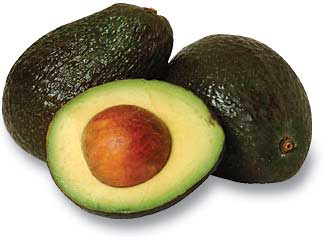Avocado: Alligator Pear
—1928 SoCal Road Guide
Avocados, one of the oldest cultivated plants in the Americas, originated in south-central Mexico between 7,000 and 5,000 B.C. Spanish explorers who were unable to pronounce the Aztec word for the fruit (known as ahuacatl or “testicle” because of its shape) called the fruit aguacate, leading to the guacamole we know today.

Avocado: Alligator Pear —1928 SoCal Road Guide
The avocado once had a reputation as an aphrodisiac, hence a forbidden fruit for anyone wanting to protect their image from slanderous assault. Growers were forced to sponsor a public relations campaign to dispel this ill-founded reputation before its present popularity was established.
In 1926 Rudolph Hass, a Pasadena postman planted a grove of seedlings on an acre in La Habra. Cuttings from a few established trees were grafted onto the seedlings. Through dumb luck, one seedling grew to a hardy tree, ignoring the graft that had been placed on it, and bore a particularly buttery fruit. In 1935, this variety of avocado received the first patent ever for a tree. All Hass avocado trees in California are descended from this original tree. In 2002, at elderly avocado-age of 76, Rudolph’s patented tree died of root-rot. In addition to Hass avocados, San Diego grows other varieties including Bacon, Gwen, Fuerte, Pinkerton, Reed and Zutano.
Alice Rainford reported in California Garden (June-July 1965) that the tasty green fruit was introduced to San Diegans at an early SD Floral Association’s flower show held at Mission Cliffs Park. A horticulturalist from LA “brought down a very few…cut the barely ripe fruit into tiny half-inch bits and let us taste the delicious nutty flavor.”
San Diego County now grows about 40 percent of the nation’s avocados. Fallbrook is known as the Avocado Capital of the World, hosting a festival in its honor each mid-April.
Avocados must reach full maturity before they are picked, however, they do not soften on the tree. Grown year-round, a single avocado tree may produce up to 400 pieces of fruit annually.
